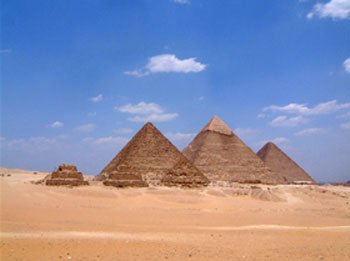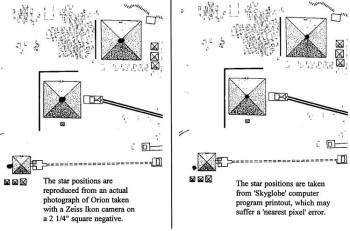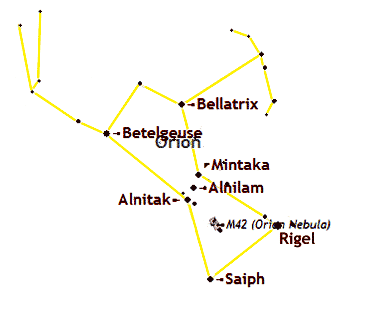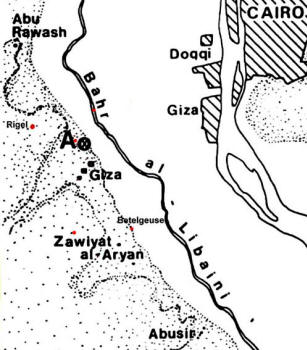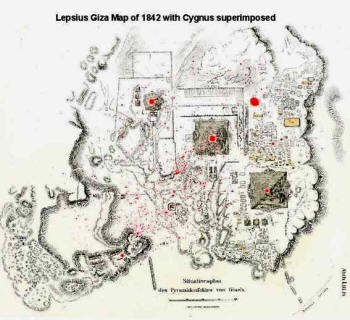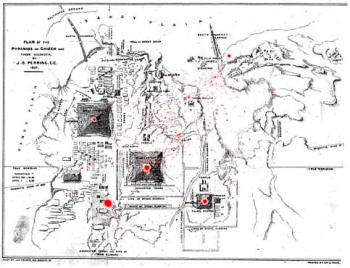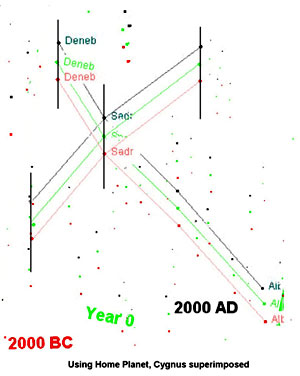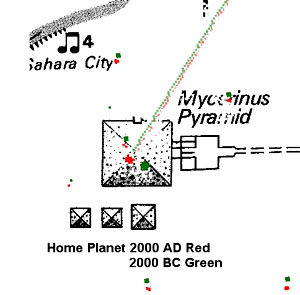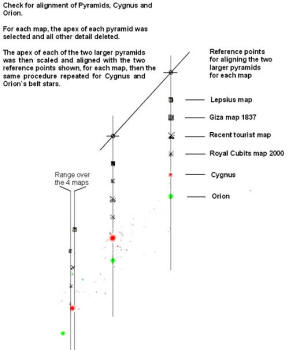|
by Andrew Collins
from
AndrewCollins Website
The three main Giza
pyramids, as viewed from the edge of the Maadi Formation
When I wrote THE CYGNUS MYSTERY, I knew that among the many incredible claims it would make, one alone would court fierce criticism, and this was the apparent connection between Giza and the Cygnus constellation. Over the years I have seen how other new theories concerning the hidden mysteries of the plateau have been ripped to shreds by detractors, and then dissected piece by piece until nothing is left intact.
It started with the theories contained
in Robert Bauval and Adrian Gilbert's seminal classic THE ORION
MYSTERY back in 1994, and has continued ever since with any
theory that veers even slightly away from the straight and narrow
path of orthodoxy Egyptology. Yet strangely, it is not usually the
Egyptologists who start the carnage, but other researchers and
writers in the fields of either revisionist history or
archaeoastronomy, neither of which are accepted as mainstream
subjects.
Thus when my friend and colleague Rodney
Hale rung me excitedly one morning in January 2005 to say that he
had superimposed the three 'wing' or 'cross' stars of Cygnus (Gienah,
aka epsilon Cygni; Sadr, aka gamma Cygni, and delta Cygni) with the
Giza pyramids and it was a perfect match, I knew then that if this
were ever to reach publication then it was going to cause a furore
that would eclipse anything I had ever written before about Ancient
Egypt.
Relative positions of the three 'belt' stars of Orion as overlaid upon the Giza pyramids as done by Rodney Hale in 1995, using both a photograph of the stars
and as they appear in
the Skyglobe program 3.5
They simply do not match, with the star corresponding to the Third Pyramid, Mintaka (delta Orionis), falling towards the southwest edge of the monument. Of course, the whole thing could simply have been a symbolic gesture on the part of the Ancient Egyptians, and thus was not meant to be precise. Yet still, it was a shame that the correlation was not exact.
Even more despair came for Rodney, a technical engineer by trade, when he attempted to match the remaining stars of Orion with other pyramid fields, as is proposed by Bauval and Gilbert in THE ORION MYSTERY.
Map of the Orion constellation
Even more confusing was that Orion's two brightest stars Rigel (beta Orionis) and Betelgeuse (alpha Orionis) do not mark an ancient monument of any kind. Once again, the correlation might not have needed to be precise, but it was a shame that the theory was not as tight as he might have liked it to be. Proposals of this kind need precision for the soul to take them seriously.
Orion superimposed
(upside down) on 1927 map of Cairo, showing
So now it seemed that for Rodney the 'wing' stars of Cygnus, linked to the plateau through its associations with the cult of Sokar - a falcon-headed god of the dead who presided over Rostau, ancient Giza, and was the earthly counterpart of the celestial sky falcon god dwn-'nwy - could be superimposed over the three main pyramids.
The simple answer is that neither of us
could be sure. However, I decided to publish these controversial
findings in THE CYGNUS MYSTERY. Naturally, there was a certain
amount of hesitation, but I wanted for the Cygnus-Giza ground-sky
alignment to speak for itself.
Still, it was a sign that I was doing something right.
Ground-sky overlay using the stars of Cygnus on a modern map of the Giza plateau. The Cygnus stars are in red, with those of Orion's belt in green.
Actual photograph of
the stars were used for this purpose
MOUND OF CREATION
For instance, Albireo (beta Cygni), the 'beak' star falls in the area of Gebel Ghibli (Arabic for 'southern hill'), a curious rock formation a few hundred meters to the south of the Great Sphinx. Robert Bauval and Simon Cox in the former's book THE SECRET CHAMBER (1999) proposed that Gebel Ghibli might have acted as a physical representation of a mythological primeval hill, or Mound of Creation.
Cox had already investigated this
strange hillock, after it had been highlighted as significant in the
remarkable landscape geometry of David Ritchie. Cox sensed that it
held the key to locating the lost Shetayet shrine of Sokar, said to
have been somewhere in the area. Ritchie had felt that it was a
'gateway' into Giza's hidden dimensions.
It is dedicated to a holy man named Hammad el-Samman, said to have once occupied the well in some bygone age. According to a little known tradition still held by the village elders of Nazlet el-Samman (named after the saint), Hammad el-Samman guarded the entrance to an underground city or palace located beneath Nazlet el-Samman, which is due east of the Great Sphinx (where Edgar Cayce predicted that the Egyptians Hall of Records would be found).
Thus to find that the Cygnus star
Albireo, the mouth or gullet or the celestial bird, fell nearby,
albeit beyond the long linear stone structure known as the Wall of
Crows (see below), was interesting indeed, and worthy of further
investigation.
Strangely, most posts were fairly
positive, especially after able researchers went away and did their
own Cygnus-Giza overlay, and saw that it was accurate. Others,
however, would not even accept that Cygnus was known to the Ancient
Egyptians, never mind it being linked with the plateau.
The answer is that it falls northwest of the Second Pyramid on the edge of the so-called Western Cemetery, which lies west of the Great Pyramid. This is made up of dozens of mastaba tombs from the Fourth, Fifth and Sixth Dynasties, which belong to those nobles and their families connected with the royal royal dynasties. They were built for priests, priestesses, prophets, tradesmen and arguably even the architect of the Great Pyramid.
The Deneb spot covers a fairly large mastaba designated LG14, after the numbering of German Egyptologist Carl Richard Lepsius (1810-1884), who surveyed the plateau, and produced an impressive map dated 1842 (see below).
The Lepsius map of 1842 showing the Cygnus stars overlaid in red.
Note the Deneb spot
obscuring mastaba LG14 on the edge of the Western Cemetery
Lepsius found the tomb to be devoid of
any artifacts or inscriptions, and thus it was simply catalogued and
forgotten about. Nothing more is currently known about LG14, and
there is every chance that, if not pillaged in ancient times, it was
built but never used. As such, no further light can be thrown on the Deneb spot, as we refer to it.
Perhaps what we are looking for here is underground, or it is simply the position of a sight line overlooking the rest of the plateau. Either way, the Cygnus-Giza correlation should not be dismissed simply because Deneb does not hit anything obviously important, especially since Orion's own brightest stars, Rigel and Betelgeuse, fail themselves to mark any ancient monument.
The John Perring's 1837 map of the Giza plateau. The Cygnus stars are in red. Note also the 'well' (Beer el-Samman) and 'sycamores' marked between the Great Sphinx and Gebel Ghibli.
Note also the
proximity of the 'beak star' Albireo (beta Cygni).
THE PROPER MOTION OF STARS
It was a valid point, and so a check on the proper motion of Cygnus's key stars produced the following slow movements in any one year against the stellar background:
The proper motion of
the principal stars of Cygnus over a period of 4,000 years,
Now all this might look confusing, but what it says is that, as Robert Bauval and Graham Hancock have said in connection with the 'belt' stars of Orion, there is no significant shift in the relative positions of the stars over this time.
Only one star in Cygnus is moving faster than the rest, and this is Gienah (epsilon Cygni), which does shift slightly with respect to the Cygnus-Giza overlay, as is shown below.
The relative shift of the star Gienah (epsilon Cygni)
with respect to its
position in relation to the Third Pyramid over a period of 4,000
years
As is plain to see, the shift is minimal, and does in no way change anything regarding the original proposal of the Cygnus-Giza correlation.
The other two Cygnus 'wing' stars, delta Cygni, corresponding with the Great Pyramid, and Sadr (gamma Cygni), corresponding with the Second Pyramid, move so little that it is unnoticeable on a small scale map of the pyramid field.
We are, however, not leaving the matter
here. Rodney Hale and I shall continue to examine other astronomical
programs that provide the proper motion of stars, and check to see
whether they correspond with the shifts in position offered here.
In order to counter this argument, Rodney superimposed the 'wing' stars of Cygnus and the 'belt' stars of Orion over four different maps of the plateau, and then brought them together in one diagram (seen below).
The variations of pyramid positions relative to the stars of both Cygnus (in red) and Orion (in green) using four different maps
This shows the width of variations of
pyramid positions relative to the stars of both Cygnus and Orion. As we can see, there is very little difference in the positions of the pyramids from one map to the next, making no difference whatsoever to the relative positions of either the Cygnus or Orion stars when superimposed on the plateau. Without any question, the Cygnus stars align much better than those of Orion.
Once again, such ground-sky correlations, if meaningful, might be symbolic alone, and not need to be actual, allowing still for the possibility that the three pyramids represent Orion and not Cygnus. However, visually Cygnus wins hands down.
Rodney Hale and I will continue to consider other
maps or photographs of the plateau with regards to the Cygnus-Giza
correlation.
These are quite clearly ridiculous observations. Not only does the well appear on the Perring map of 1837, which shows its location prior to the siting of the modern Islamic cemetery, but it also appears on the Lepsius map of 1842 (see below):
The well Beer el-Samman marked as a dot between two palm trees and two sycamore fig trees. On the left (south) we see the rock outcrop Gebel Ghibli (Arabic for 'southern hill'), and on the right the Great Sphinx.
At the left-hand base
is the end of the linear feature known as the Wall of the Crow
There seems little question that this
holy well would have played a function in Ancient Egyptian
geomythics, especially since it falls inside the plateau, being
placed as it is on the northside of the so-called Wall of the Crow,
a linear stone feature made of cyclopean blocks which dates to the
late Fourth Dynasty and is thought to be part of the plateau's
southern boundary wall.
I suspect it was in magical rites
associated with Hathor, possibly a female patron of the plateau, and
possibly Nut, the sky-goddess, whom Dr Robin Wells identifies with
the Milky Way. It might equally have some connection with the cult
of Sokar, who was guardian of underworld realms, which were forever
in darkness.
However, it is more likely to date back to dynastic times, particularly as its accompanying sycamore is perhaps a descendent of one said to have existed in Heliopolis. It was sacred to the goddess Nut, who was occasionally shown in Ancient Egyptian art as standing in a sycamore tree pouring either water or wine from a jar on to a human-headed bird, representing the ba, or soul, of a deceased person. At its base was depicted just such a holy well, or spring.
Often Hathor replaced Nut in this scene,
showing the relationship between the two goddesses, who have much in
common.
Beer el-Samman as it appears today in the Islamic cemetery,
shaded by a sycamore
fig tree.
I doubt very much whether it leads directly to a lost underworld domain, although it is interesting that the lowest level of the so-called 'Tomb of Osiris', discovered in the 1920s beneath the causeway to the Second Pyramid by Egyptologist Salim Hassan, possesses a pit thought to lead into an unexplored tunnel now beneath the present water table, this being high enough to fill the existing chamber to a depth of at least 1.5 meters.
Could the story of the holy man Hamman el-Samman guarding the entrance to an underground palace or city be the memory of real passages that permeate the living rock beneath the plateau's water line?
Conclusions
In the knowledge that Dr Robin Wells, following an examination of the astronomical orientation of the causeway of Sahure's sun temple at Abu Ghourab, south of the Giza plateau, concluded that this king, who opened the Fifth Dynasty, singled out Deneb, Cygnus's brightest star, as in some way special, then I think the answer is going to be 'yes'.
Yes, in that such superimpositions, whether involving the stars of Orion or Cygnus, put into perspective the hidden dimensions of places such as the Giza plateau. Part of me wants to dismiss the Cygnus-Giza correlation as the actions of the wily Cosmic Joker having his fun. Yet then again, if I had dismissed the correlation then I would probably never have found Beer el-Samman, or turned up the information on the strange bird catacomb beyond the northwestern edge of the plateau, which Vyse and Perring wrote contained 'bird mummies', as well as 'part of a large bird '.
Thus in conclusion, I consider that the
Cygnus-Giza correlation has not hindered my investigations on the
plateau in the least. In fact, it has given it an entirely new
dimension that I now intend exploring to its fullest.
|

